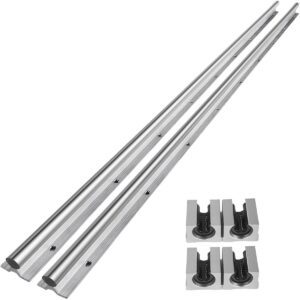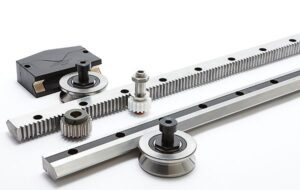Outline for Linear Motion Track
| Main Heading | Sub-Headings |
|---|---|
| Introduction to Linear Motion Track | Importance in engineering, Evolution of motion systems |
| Linear Motion Track | Definition, Working principle |
| Types of Linear Motion Track | Profile rail, Round rail, Roller track, V-groove track |
| Materials Used in Linear Motion Track | Steel, Aluminum, Stainless steel, Composite materials |
| Components of Linear Motion Track | Rails, Carriage, Bearings, End stops, Mounting hardware |
| Functions of Linear Motion Track | Precision, Load support, Stability, Smooth motion |
| Advantages of Linear Motion Track | High accuracy, Long service life, Versatility |
| Disadvantages of Linear Motion Track | Cost, Installation challenges, Maintenance needs |
| Applications of Linear Motion Track | CNC machines, 3D printers, Robotics, Automotive, Furniture |
| Linear Motion Track in DIY Projects | Maker uses, Common mistakes |
| Industrial Applications of Linear Motion Track | Manufacturing, Aerospace, Warehousing |
| Comparison of Linear Motion Track vs Other Motion Systems | Ball screws, Belt drives |
| Buying Guide for Linear Motion Track | Load capacity, Travel distance, Accuracy |
| Where to Buy Linear Motion Track | Online suppliers, Industrial distributors, Hardware stores |
| Installation of Linear Motion Track | Tools required, Step-by-step guide |
| Maintenance of Linear Motion Track | Cleaning, Lubrication, Inspection |
| Common Issues with Linear Motion Track | Misalignment, Noise, Wear |
| Solutions for Linear Motion Track Issues | Adjustments, Replacements, Proper care |
| Upgrading Linear Motion Track | Adding sensors, Automation |
| Safety Considerations for Linear Motion Track | Load limits, Handling practices |
| Linear Motion Track in CNC and Robotics | Role in precision engineering |
| Linear Motion Track in Aerospace and Automotive | Special requirements |
| Future of Linear Motion Track | Smart tracks, Sustainable materials |
| Global Market Trends of Linear Motion Track | Key players, Demand growth |
| Conclusion | Key insights |
| FAQs | At least six relevant FAQs |
Introduction to Linear Motion Track
The linear motion track is one of the most vital components in modern engineering and manufacturing. It provides controlled, precise, and smooth linear movement across countless industries. Whether in CNC machines cutting metal, 3D printers building prototypes, or robotic arms assembling cars, the linear motion track ensures efficiency and accuracy.
Over time, these tracks have evolved from simple sliding rails to sophisticated, precision-engineered systems capable of handling massive loads while maintaining microscopic accuracy. Today, they are at the heart of advanced automation and DIY maker projects alike.
Linear Motion Track
A linear motion track is a guiding system that enables movement along a straight path with reduced friction. It consists of rails and a carriage that moves smoothly along them, often with the help of rolling elements like bearings or rollers.
The primary purpose is to convert rotary motion into linear motion or to allow precise movement in machines that require high repeatability. Unlike simple slides, linear motion tracks are designed for industrial-grade reliability, precision, and load-bearing capacity.
Types of Linear Motion Track
Several types exist to meet different needs:
Profile Rail Tracks – High precision, suitable for CNC and robotics.
Round Rail Tracks – Economical, widely used in DIY and light-duty setups.
Roller Tracks – Excellent for handling heavier loads with smooth operation.
V-Groove Tracks – Used in rugged environments where dust or debris may interfere.
Materials Used in Linear Motion Track
Material selection impacts durability, weight, and performance:
Steel – Strong, durable, best for heavy-duty applications.
Aluminum – Lightweight and corrosion-resistant.
Stainless Steel – Ideal for cleanrooms, food processing, and medical equipment.
Composite Materials – Provide specialized solutions for lightweight applications.
Components of Linear Motion Track
A linear motion track includes:
Rails – The guiding path for motion.
Carriage/Slider – Moves along the rail, carrying loads.
Bearings – Rolling elements for smooth movement.
End Stops – Prevent overtravel.
Mounting Hardware – Screws, brackets, or plates for securing.
Functions of Linear Motion Track
The main functions are:
Precision – Ensures exact movement.
Load Support – Handles weight without deformation.
Stability – Prevents wobbling during motion.
Smooth Motion – Reduces friction for efficiency.
Advantages of Linear Motion Track
High Accuracy – Ideal for CNC, robotics, and 3D printing.
Long Service Life – Built for durability.
Versatility – Applicable in multiple industries.
Energy Efficiency – Reduced friction saves power.
Disadvantages of Linear Motion Track
Cost – More expensive than simple slides.
Installation Challenges – Requires precise alignment.
Maintenance Needs – Needs lubrication and cleaning.
Applications of Linear Motion Track
Linear motion tracks are everywhere:
CNC Machines – Ensuring precision in milling and cutting.
3D Printers – Providing accurate layer placement.
Robotics – Guiding robotic arms.
Automotive – Used in assembly lines.
Furniture – High-end applications like sliding desks or drawers.
Linear Motion Track in DIY Projects
Makers often use linear motion tracks in:
DIY CNC routers.
Laser engravers.
3D printers.
Mistakes include poor alignment or choosing undersized tracks for heavy loads.
Industrial Applications of Linear Motion Track
In industries, they are used for:
Aerospace assembly.
Automated packaging.
Medical equipment.
Material handling.
Comparison of Linear Motion Track vs Other Motion Systems
| Feature | Linear Motion Track | Ball Screw | Belt Drive |
|---|---|---|---|
| Accuracy | High | Very high | Moderate |
| Cost | Medium | High | Low |
| Speed | Moderate to high | Moderate | High |
| Load Capacity | High | Very high | Limited |
Buying Guide for Linear Motion Track
Consider:
Load Capacity – Match track strength with expected weight.
Travel Distance – Ensure sufficient length.
Accuracy Requirements – CNC needs higher precision than furniture.
Environment – Dust, moisture, and temperature affect choice.
Where to Buy Linear Motion Track
Online – Amazon, AliExpress, eBay.
Industrial Suppliers – THK, Hiwin, Bosch Rexroth.
Hardware Stores – Smaller, general-use tracks.
Installation of Linear Motion Track
Steps:
Mark and drill mounting holes.
Secure rails with bolts.
Attach carriage carefully.
Check for alignment.
Lubricate.
Maintenance of Linear Motion Track
Clean rails regularly.
Apply lubrication to prevent sticking.
Inspect for cracks and wear.
Common Issues with Linear Motion Track
Misalignment – Causes uneven wear.
Noise – Often from lack of lubrication.
Wear – Due to overloading or poor maintenance.
Solutions for Linear Motion Track Issues
Realign rails.
Lubricate and clean.
Replace worn bearings.
Upgrading Linear Motion Track
Upgrades include:
Adding sensors for monitoring.
Automating with actuators.
Stronger mounts for stability.
Safety Considerations for Linear Motion Track
Avoid exceeding load ratings.
Protect from dust and debris.
Ensure proper installation.

Linear Motion Track in CNC and Robotics
Precision applications like CNC milling and robotic assembly rely heavily on tracks for accuracy and efficiency.
Linear Motion Track in Aerospace and Automotive
Tracks used here must endure vibration, high stress, and temperature variations, making quality paramount.
Future of Linear Motion Track
The future will bring:
Smart tracks with IoT monitoring.
Eco-friendly materials.
Advanced composites reducing weight without sacrificing strength.
Global Market Trends of Linear Motion Track
Growing demand in automation and robotics.
Leading manufacturers: THK, Hiwin, NSK, Bosch Rexroth.
Rising adoption in DIY maker communities.
Conclusion
The linear motion track is the backbone of precision engineering, ensuring smooth and accurate movement across industries. From DIY projects to aerospace, its applications are vast and growing. With advancements in smart technology and sustainable materials, the future of linear motion track looks stronger and more efficient than ever.
FAQs
What is a linear motion track?
A guiding system that enables straight-line movement with precision and low friction.
Where is linear motion track used?
In CNC machines, 3D printers, robotics, aerospace, and furniture.
What materials are used in linear motion tracks?
Steel, aluminum, stainless steel, and composites.
Are linear motion tracks expensive?
They range from affordable DIY tracks to costly industrial-grade systems.
How do you maintain linear motion tracks?
By cleaning, lubricating, and inspecting regularly.
Which brands make the best linear motion tracks?
THK, Hiwin, Bosch Rexroth, NSK.
Inbound and Outbound Link Suggestions
Inbound Links (Internal):
Link to article on CNC machine components
Link to robotic motion systems
Link to linear bearings vs slides
Outbound Links (External):



